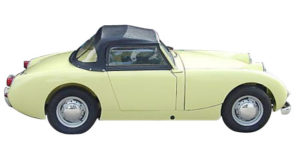ARTICLE AND PHOTOS PROVIDED BY ANDY LINDBERG.
FIRST PUBLISHED IN INTERMARQUE MONTHLY IN APRIL 2012
Sometime in 1956, Len Lord had a chinwag with Donald Healey. Lord was the grand pooh-bah of the huge British Motor Corporation. Before that he ha d headed the Austin Motors Company. After Austin and the Nuffield Organisation (Morris, MG, Riley and Wolseley) merged to form BMC in ‘52, Austin had become the alpha dog. Healey headed up a much smaller firm, the Donald Healey Motor Company, but he and Lord had done business before. In 1952, at the London Motor Show, they created the joint effort to produce the wildly successful Austin-Healey 100. By 1956, however, both men realized that there was a vacant niche in the sports car market. Before World War II, when Austin and Morris had been separate companies, each had entry-level sports cars. Austin had its Austin Seven Nippy and Ulster models while Morris had a multitude of MG variants.
d headed the Austin Motors Company. After Austin and the Nuffield Organisation (Morris, MG, Riley and Wolseley) merged to form BMC in ‘52, Austin had become the alpha dog. Healey headed up a much smaller firm, the Donald Healey Motor Company, but he and Lord had done business before. In 1952, at the London Motor Show, they created the joint effort to produce the wildly successful Austin-Healey 100. By 1956, however, both men realized that there was a vacant niche in the sports car market. Before World War II, when Austin and Morris had been separate companies, each had entry-level sports cars. Austin had its Austin Seven Nippy and Ulster models while Morris had a multitude of MG variants.
By 1956, BMC had the Austin-Healey going gangbusters in the upper middle class while the newly introduced MGA was trying to fight off the Triumph TR3 in the middle market. Other than Morgan, however, no one was producing a truly low cost sports car. Since Morgan’s miniscule production capacity did not position that company as a real BMC competitor in any niche, Lord and Healey agreed there was a profitable opportunity.
It’s not clear whether, during this meeting, Healey was actually asked to design a small, low-cost sports car, but Donald Healey didn’t rest on formalities. Arriving back at his headquarters in Warwick, he called in his son, Geoff, and told him to get busy on the project. (Asking his son to pilot the project was not exactly like you asking your son who just built a birdhouse in woodshop to design you a skyscraper. Geoff was a recognized automotive engineering genius and had been an integral part of all Healey’s post-war cars, the Silverstone, the Nash-Healey, and the 100.)
The Healey Company quickly began design work. In order to reduce costs, their car was designed to use as many parts from the BMC corporate parts bin as possible. Most came from the Austin A35: front suspension, gearbox, back axle, and a mildly tuned version of the Austin A-Series engine. A slightly more expensive rack-and-pinion steering rack came from the Morris Minor, however, when the A35’s cam-and-peg box would not fit without six ball-joints gumming up the works.
Body designs were done by Gerry Coker who was also penned the Austin-Healey 100. One cost reduction idea was to have identical front and rear panels, but this was dropped early in the development process. One expensive design idea, however, survived through the first prototype car—pop-up headlights. These lights were to fall back into the sheet metal and stare at the sky when at rest (much like the later Lamborghini Miura and Porsche 928). Excessive and unreliable mechanical gadgetry for this system ruled it out. When Coker left for America in 1957, his successor Les Ireland finished off the design and the Bugeye acquired its bug eyes.
At this point the car did not yet have a name. Around the shop, it was known either as the “Tiddler” or the “Poor Man’s Ferrari.” Donald Healey finally picked “Sprite,” and BMC obtained permission to use the name from Daimler who had acquired it from Riley.
The original plan was to produce the car at Austin’s plant at Longbridge but that facility was unable to fit the power train from underneath the car. The MG factory at Abingdon was the only plant available to BMC that could fit the units. So when the car actually went into production, it did so alongside the larger Austin Healeys and the MGA.
BMC took the wraps off the Austin-Healey Sprite on May 20, 1958. Location for the unveiling was Monte Carlo. Since it was just before that year’s Monaco Grand Prix, many automotive journalists were on hand. 8700 cars were sold in 1958, at a price of £669.
1956 Sprite Design Drawing by Gerry Coker: http://www.ado13.com/CokerBugeyeDrawing.jpg
Healey and Lord at the 1952 Earl’s Court Motorshow: http://members.home.nl/rgubbels/history.htm
(Author’s note: This article was to be the first chapter of a book titled Spridgefire: the fight for the bottom shelf of the U.S. sports car market. I’ll never finish that book so the words are appearing here. Also unfortunately, this newsletter does not have the resources to buy publication rights for the relevant pictures so I’ve enclosed web citations that you can click for the eye candy.)